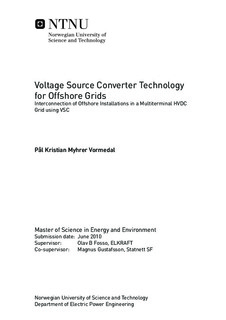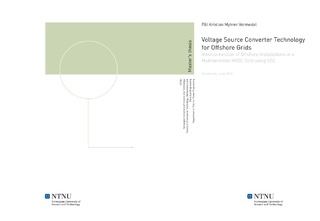| dc.contributor.advisor | Fosso, Olav B | nb_NO |
| dc.contributor.advisor | Gustafsson, Magnus | nb_NO |
| dc.contributor.author | Vormedal, Pål Kristian Myhrer | nb_NO |
| dc.date.accessioned | 2014-12-19T13:52:25Z | |
| dc.date.available | 2014-12-19T13:52:25Z | |
| dc.date.created | 2010-10-28 | nb_NO |
| dc.date.issued | 2010 | nb_NO |
| dc.identifier | 359567 | nb_NO |
| dc.identifier | ntnudaim:5358 | nb_NO |
| dc.identifier.uri | http://hdl.handle.net/11250/256956 | |
| dc.description.abstract | This master thesis has investigated the possible application of voltage source converters (VSC) for the interconnection of offshore installations, i.e. wind farms and petroleum platforms, in a multiterminal DC (MTDC) grid. The master thesis is written at the Norwegian University of Science and Technology, Department of Electric Power Engineering and is a continuation of the project written during the autumn of 2009. The work has been carried out in cooperation with Statnett SF, the Norwegian TSO, as a contribution to an ongoing research and development program on offshore electrification. The motivation behind this thesis is the possibilities the VSC technology bring about for the realization of renewable wind energy far from shore and supplying petroleum installations from the main onshore grid, thus reducing emissions. A theoretical study has been conducted, describing the VSC technology from basic operation to topics related to the implementation of a high power rated offshore MTDC grid. A suggested model of a small power system was established in the simulation program PSS®E. The model consisted of a four converter MTDC connecting three separate AC systems. One of the AC systems was a simplified representation of a main onshore grid, and the other two were small offshore AC grids made up of a wind farm and a petroleum platform. The MTDC was modeled using ABB s HVDC Light Open model v 1.1.9-2, developed for use in PSS®E. A series of dynamic simulations have been performed using the model to demonstrate and analyze the principles of operation for a MTDC and the interaction between the AC systems and the MTDC. The dynamic simulations demonstrate the basic operation of a MTDC with a master-slave control scheme for the active power control, as implemented in the HVDC Light model. The simulation results confirm the functionality of a MTDC as described in the theoretical analysis of the technology.The analysis based on both the literature and simulations conclude that VSC technology is a realistic solution for an offshore grid with the objective of supporting passive network installations far from shore. Simulation results conclude that an advanced control system for the active power control operation (Poption) of all the converters in a MTDC may greatly improve the performance of the system following a disturbance. Both theoretically and through simulations it has been demonstrated that the VSC MTDC provides stability improvements to the connected AC grid, by actively controlling the injected active and reactive power to the grid. The possibility to use the MTDC as an alternative path for transferring large amounts of power has been investigated, and this was found to be beneficial for the system. The difficulties related to fault protection in a MTDC have been highlighted, and a theoretical analysis concluded that the protection scheme using IGBT circuit breakers is the preferred solution with present available technology. | nb_NO |
| dc.language | eng | nb_NO |
| dc.publisher | Institutt for elkraftteknikk | nb_NO |
| dc.subject | ntnudaim:5358 | no_NO |
| dc.subject | SIE5 energi og miljø | no_NO |
| dc.subject | Energibruk og energiplanlegging | no_NO |
| dc.title | Voltage Source Converter Technology for Offshore Grids: Interconnection of Offshore Installations in a Multiterminal HVDC Grid using VSC | nb_NO |
| dc.type | Master thesis | nb_NO |
| dc.source.pagenumber | 321 | nb_NO |
| dc.contributor.department | Norges teknisk-naturvitenskapelige universitet, Fakultet for informasjonsteknologi, matematikk og elektroteknikk, Institutt for elkraftteknikk | nb_NO |

